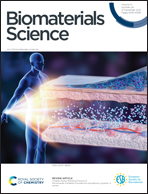Water-soluble branched polymer for combined chemo-immunotherapy of bacterial infections†
Abstract
Bacterial infection is one of the most significant public health challenges due to the limited choices of antibiotics which can overcome antibiotic-resistant bacteria. The promising nonantibiotic therapeutic alternatives for antibiotic-resistant bacterial infection are urgently needed to reduce the disease burden. Herein, the water-soluble branched poly(amino ester) with inherently antibacterial (chemotherapy) and enhanced inflammatory response activity (immunotherapy) was prepared via Michael addition polymerization to combat bacterial infection. These polymers can not only damage bacteria walls, leading to the death of bacteria but also activate macrophages to low-output nitric oxide (NO), TNF-α and interleukin (IL)-1β to kill and clean bacteria. Importantly, these polymers can efficiently inhibit aminoglycoside-resistant P. aeruginosa even at a low dose of 500 nmol L−1. Furthermore, these polymers can treat subcutaneous bacterial infections in vivo. In this study, we first report a water-soluble branched polymer to combat bacteria through the combination of chemotherapy and immunotherapy, which will open a new path to design promising potential therapeutic alternatives for bacterial infection.



 Please wait while we load your content...
Please wait while we load your content...